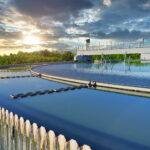It is generally accepted that one of climate change’s main impacts is on the hydrological cycle, the severe impacts of which we are experiencing already today. The wet areas are getting wetter, the dry areas drier, and extreme weather events such as floods, droughts and storm surges have become everyday occurrences.
Finding ways to adapt to these challenges is vital for sustainable development and the survival of communities. The technologies to be better prepared for and mitigate many of these hazards are already there, though those looking for appropriate solutions inevitably face the difficult task of identifying and evaluating a bewildering range of options.
A summary of six ways in which climate adaptation technologies for water can strengthen response to climate change is outlined here:
-
Facing the uncertainty and risks of climate change
Risk and uncertainty are inherent challenges for any water manager, and makes it difficult to make robust decisions on what changes in water management domain are to be expected, and what are to be prepared for first.
The uncertainty can be reduced by implementing adaptation technologies and approaches that help better understand and evaluate the impacts of climate change. For example, Hazard and risk assessment technologies help establish linkages between regional climate change and its impacts at the local level, and identifies the specific risks to the water resources sector. Vulnerability assessments, on the other hand, look at the interaction between climate change impacts and the characteristics of the area, economic activity, ecosystem, or community in question.
-
Facing water shortages and droughts
The Intergovernmental Panel on Climate Change (IPCC) findings show that each degree of global warming is projected to decrease the availability of renewable water resources by at least 20%, for additional 7% of the global population. The percentage of global population living in river basins with new or exacerbated water scarcity is projected to increase, to as high as 13% (at 5 degrees Celsius). Reduced flows and increased water stress also have strong links to ecosystem health and water quality.
Adaptation technologies for better water allocation can help in sharing existing resources among users in a way that is equitable, and to ensure maximum benefits for all, including the environment. Water augmentation and water storage technologies can in turn increase the water available for productive use through active recharge or protection of existing resources. We also know that it is unmanaged demand that often drives water scarcity. Here, water efficiency and demand management measures help reduce inefficient use and waste of freshwater though improved technologies and better oversight of water use. Where this is not sufficient, alternative freshwater sources can be explored.
-
Facing floods
Communities will also have to adapt to riverine floods, flash floods, urban floods and sewer overflows, as well as flood risks resulting from glacier lake bursts. Today, hydrological disasters claim the largest number of human victims and economic damage in comparison to other types of disasters. From 2004 – 2013 the average number of victims of hydrological disasters worldwide was more than 90 million annually, with annual economic damages of more than 30 billion USD.
Adaptation technologies for riverine flood protection – including both green and grey infrastructure – will become key in water infrastructure portfolios in many places of globe. Similarly, the increasing rates of urbanisation and density of land developments create less and less space for water to get away. Urban flooding can be dangerous and devastating due to its rapid onset and the exposure of large populations (and assets) to risks in a relatively small area, thus necessitating urgent need for interventions for urban storm water mitigation in world’s megacities and beyond. Just as important are measures in remote mountain regions, where adaptation technologies for handling the accumulating melt water puts glacial lakes at increasing risk from glacial lake outbursts.
-
Keeping our waters clean
Even where water resources remain available, many forms of water pollution will be exacerbated as a result of rising temperatures and precipitation intensity. This will affect water quality through greater pollutant (e.g. pathogens and pesticides) transport to freshwater bodies, and increased erosion, which in turn can potentially increase absorbed pollutants such as phosphorus and absorbed heavy metals.
The good news is that many technologies and approaches for mitigating water pollution are known and available already today. Improved land management and agricultural practices can mitigate these risks by limiting nutrient leakage, and numerous technologies for mitigating pollution at the source, flood proofing for water quality and improved water treatment capacity can be employed at smaller and larger scales.
-
Maintaining safety living on the coastal areas
More than one billion people currently live in coastal areas, and the populations are growing rapidly and could increase to between 1.8 and 5.2 billion by 2080. Coastal communities are at particular risk from climate change due to sea level rise, storm surges and other extreme weather events.
Built and natural infrastructure can help protect the shoreline and help manage erosion and flooding hazards, especially in areas with high population densities and valuable assets. Accommodation and management of risks can in turn respond to risks by revising and reorganizing human activities in the coastal zone. Technologies for limiting saltwater intrusion can further maintain the natural balance between freshwater and seawater in the coastal aquifers.
-
Being prepared when disaster strikes
Despite any preparations and precautionary adaptation measures put in place, there are times when none of these measures can prevent the disaster event altogether. When it strikes, appropriate adaptation technologies for disaster preparedness to evacuate people and protect key infrastructure can significantly reduce the damage and risks to people and infrastructure.
Early warning technologies provides crucial information to responsible institutions about an approaching disaster, enabling them to warn at-risk communities and initiate disaster response operations. Implementing disaster response technologies in turn can facilitate timely evacuation and ensure that exposed communities understand and follow evacuation procedures in the event of a natural disaster.
Curious to know more about adaptation technologies for water?
Download the guide: Climate Change Adaptation Technologies for Water: A practitioner’s guide to adaptation technologies for increased water sector resilience. (link)
This publication includes 102 adaptation technologies for building resilience to climate change-induced hazards in the water sector with accompanying links to technology description sheets for each.
Partner organisations:
UNEP-DHI: http://www.unepdhi.org/
CTCN: https://www.ctc-n.org/
UNEP-DTU: http://www.unepdtu.org/
About the authors
UN Environment-DHI Centre: Maija Bertule
CTCN: Lars Rosendahl Appelquist and Jason Spensley
UNEP DTU Partnership: Sara Lærke Meltofte Trærup and Prakriti Naswa








